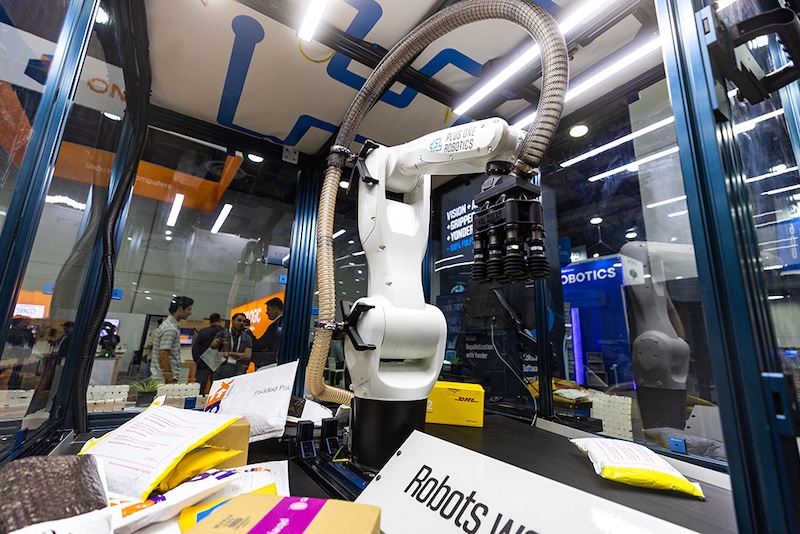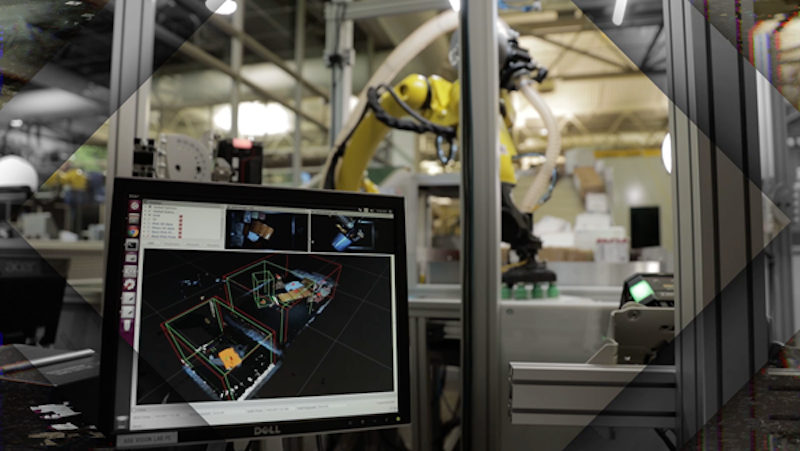Plus One Robotics is a US-based company that develops vision and AI software for warehouse and logistics automation.
Founded in 2016 and headquartered in San Antonio, Texas, the company focuses on solving one of the most persistent challenges in logistics: how to automate parcel handling in environments full of irregular, unpredictable packages.
Its core products are vision-driven systems for robotic arms, which can be deployed for palletizing, depalletizing, and parcel singulation.
While Plus One is often described as a software company, its offerings go beyond code. The company sells integrated work cells that combine its vision software, AI, and human-in-the-loop system with standard industrial robots from partners such as Yaskawa and Fanuc.
On its website, Plus One lists complete palletizing systems “starting at $155,000”, suggesting it provides full turnkey solutions rather than software alone. The “dynamic” description refers to the system’s ability to adapt in real time to changing package shapes and conditions, aided by remote human supervisors when necessary.
Financially, Plus One has raised significant venture backing, including a $50 million Series C round in 2022, and its systems are now deployed by global logistics leaders such as FedEx, DHL, and Geodis.
With growing demand for warehouse automation, the company appears well-positioned in a market where labor shortages and shipping disruptions are accelerating adoption.
Q&A with Erik Nieves
Robotics & Automation News: Plus One Robotics emphasizes AI-driven systems with humans in the loop. Can you explain why this approach is better suited to warehouse operations than full autonomy?
Erik Nieves: Machines are fast, precise and great at high-volume tasks, but they aren’t naturally adaptable when something unexpected comes up like a crushed box, an oddly shaped parcel.
Humans, on the other hand, are versatile problem-solvers but slower on repetitive work. Combining the two creates a system that leverages the strengths of both.
Robots handle the predictable, high-throughput work, while humans step in only when exceptions arise, and even then, the humans are controlling the robots remotely. The result is a more efficient operation that doesn’t stall when real-world variability occurs.
R&AN: How are your systems helping warehouses manage global shipping disruptions (like delays, reroutes, and bottlenecks) without requiring additional labor?
EN: Global disruptions can create sudden spikes in volume that overwhelm human labor. Our human-in-the-loop model lets warehouses scale quickly without adding headcount. Robots handle routine parcel flows and humans oversee exceptions across multiple systems remotely.
That flexibility ensures operations continue smoothly even when shipping routes change, demand surges or returns spike. Warehouses don’t need to hire temporary labor; they can absorb disruptions in real time, keeping goods moving without slowing throughput.
R&AN: What role does AI play in enabling robots to quickly adapt to new or unpredictable conditions in high-volume logistics environments?
EN: Vision-driven AI is what makes robots effective in real-world warehouse environments. Unlike legacy systems that require highly structured, predictable conditions, our robots can see parcels in 3D, classify them and decide how to pick, place or route them in real time.
They handle irregular packaging, glossy or reflective surfaces, complex graphics and oddly shaped items, learning from every interaction. Human intervention ensures the system adapts instantly when something truly unexpected appears.
This creates a continuous feedback loop where AI and humans improve together. Robots bring scale, consistency and speed, while humans provide judgment on exceptions.
Over time, the system becomes smarter and more flexible, capable of keeping operations running smoothly even during peak surges or when workflows shift. It’s not about replacing humans, but rather amplifying a human’s capabilities with intelligent, adaptable machines.
R&AN: From your perspective, how does the combination of robotics and human oversight impact warehouse productivity and worker roles in the long term?
EN: Automation frees people from repetitive, physically demanding tasks, allowing them to focus on problem-solving and oversight. One human can now supervise multiple robotic systems, stepping in only when exceptions occur.
This reduces strain, creates higher-value roles and boosts productivity because humans are doing what they do best while robots handle the routine work.
R&AN: Looking ahead, what do you see as the next major challenge in warehouse automation, and how is Plus One preparing to address it?
EN: The biggest challenge isn’t the robots themselves, it’s scale and integration. Most warehouses are brownfield sites with legacy systems, tight layouts and mixed workflows. Deploying automation successfully in these environments requires flexibility.
That’s why we focus on vision-driven, AI-enabled systems that adapt to different facilities, work alongside legacy equipment and scale quickly without requiring expensive overhauls. Our goal is to deliver operational value fast while minimizing disruption.
Beyond technical integration, resilience is key. Supply chains will continue to face shocks (like tariffs, labor shortages and demand surges), and automation has to bend without breaking.
By combining robotic consistency with human judgment, warehouses can absorb disruptions while maintaining throughput. Automation becomes not just a tool for speed or efficiency, but a foundation for long-term stability, allowing operators to meet rising demand without sacrificing accuracy or workforce engagement.

About the author: Erik Nieves is co-founder and CEO of Plus One Robotics, a software company developing 3D and AI-powered vision software for robots in logistics automation. Prior to Plus One, Erik was technology director for Yaskawa Motoman Robotics where he was responsible for the technology roadmap and emerging applications. During his 25+ year tenure at Yaskawa, Erik held a variety of leadership positions in the US and abroad. Erik serves on the board at Robotics Industries Association and is a frequent speaker and contributor to public policy on robotics.


